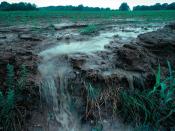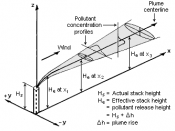Great paper, an A+ paper! Great paper!
Paul Cordova
L. Lehr
December 11, 1995
An Ecosystem's Disturbance by a Pollutant
Freedman defines a pollutant as 'the occurrence of toxic substances or energy in a larger quality then the ecological communities or particular species can tolerate without suffering measurable detriment' (Freeman, 562). Although the effects of a pollutant on an organism vary depending on the dose and duration (how long administered). The impact can be one of sublethality to lethality, all dependent upon the factors involved. These factors need to be looked at when determining an ecosystem's disturbance by a pollutant.
Some of the most frequent pollutants in our ecosystem include: gases such as sulphur dioxide, elements such as mercury and arsenic, and even pollution by nutrients which is referred to as eutrophication. Each of these pollutants pose a different effect on the ecosystem at different doses. This varied effect is what is referred to as dose and duration.
The amount of the pollutant administered over what period of time greatly affects the impact that the pollutant will have on an ecosystem and population.
Pollutants can affect both a population and an ecosystem. A pollutant on a population level can be either non-target or target. Target effects are those that can kill off the entire population. Non-target effects are those that effects a significant number of individuals and spreads over to other individuals, such is the case when crop dusters spread herbicides, insecticides. Next we look at population damage by a pollutant, which in turn has a detrimental effect on the ecosystem in several ways. First, by the killing of an entire population by a pollutant, it offsets the food chain and potentially kills off other species that depended on that organism for food. Such is the case when...


